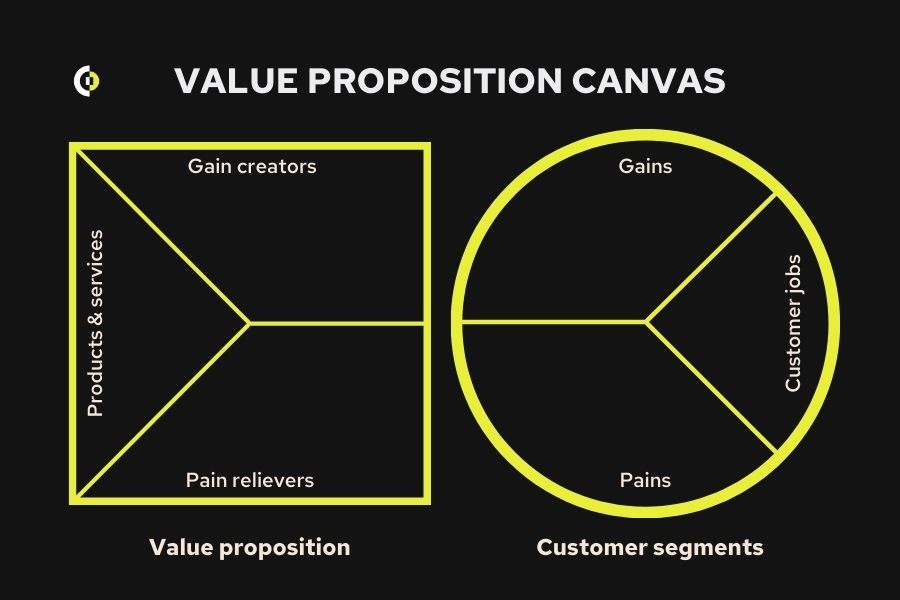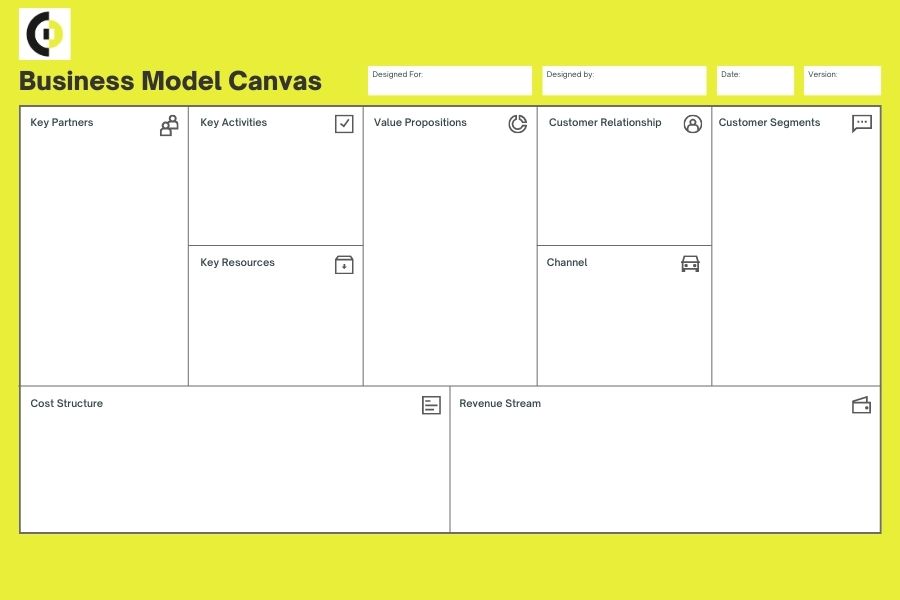In today’s dynamic market, understanding and addressing the complex needs of customers are crucial for business success. The Value Proposition Canvas, a powerful tool designed to close the divide between what customers anticipate and company offerings, is pivotal in achieving this. This comprehensive guide aims to explore the intricacies of the Value Proposition Canvas, providing insights on how to use it effectively and unlock maximum customer value.
Understanding the Value Proposition Canvas: A Deep Dive
The Value Proposition Canvas goes beyond being a graphical representation of customer wants; it is a strategic framework focusing on comprehending customers’ problems and creating products or services that genuinely address those issues. Dr. Alexander Osterwalder’s ingenious creation, the Value Proposition Canvas, is a guiding framework to ensure products and services align with what customers truly value and require. He is also the inventor of the Business Model Canvas, a strategic management tool that helps define and communicate business ideas and concepts.
Benefits of the Value Proposition Canvas
The Value Proposition Canvas is a critical business model component, aiding in decision-making and product positioning. Its advantages extend beyond merely representing what customers want. It empowers businesses to align their strategies with customer needs. Let’s delve into the key benefits:
#1 Insightful Understanding of the Customer
The canvas provides a lens through which businesses gain profound insights into customer needs and expectations. By systematically mapping customer profiles, including gains, pains, and jobs-to-be-done, companies can tailor their offerings to match customer requirements precisely.
#2 Product Development Alignment
Aligning product development with customer needs is the key to creating solutions that resonate in the market. The Value Proposition Canvas serves as a compass, guiding product development in a direction that aligns with the desires and preferences of the target audience.
#3 Achieving Product-Market Fit
Success in the market is not just about having a great product; it’s about finding the right fit between the product and the target market. The canvas facilitates this alignment, ensuring businesses develop products that meet customer needs and integrate seamlessly into the market.
#4 Resource Efficiency
Investing resources in products that lack demand can lead to inefficiencies and financial setbacks. The Value Proposition Canvas acts as a strategic filter, allowing businesses to avoid investing in products that may not resonate with the market, thereby optimizing resource allocation.
#5 Time and Cost Savings
In the fast-paced world of business, time is of the essence. The canvas streamlines the product development process by providing a structured approach, minimizing the risk of investing time and resources in ventures that may not yield positive results. This, in turn, contributes to significant cost savings.
Decoding the Value Proposition Canvas Structure
Customer Profile
In the realm of the canvas, the circle signifies the customer profile, meticulously dissected into three facets: jobs, pains, and gains. Comprehending these components is paramount, offering insights into the tasks, challenges, and desires perceived from the end-user standpoint.
- Jobs: Encompassing the tasks customers strive to achieve, spanning the realms of social, emotional, and functional endeavors.
- Pains: Unveiling the impediments hindering customers in task completion, encapsulating adverse outcomes and challenges.
- Gains: Illuminating the positive experiences and aspirations customers yearn for, distinct from the challenges and pains they encounter.
Crafting a tailored customer profile for each segment is imperative, as well as discerning the unique “jobs to be done,” pains, and gains.
Value Map
Conversely, the square etched on the canvas embodies the value proposition map, mirroring the segmentation of three integral parts aligning with the sections of the customer profile.
- Products and Services: Providing a detailed breakdown of all features, products, and services offered, forming the cornerstone of value delivery.
- Pain Relievers: Articulating how the product strategically mitigates customer pains, ensuring a smoother journey for the end-user.
- Gain Creators: Shining a spotlight on how the product contributes additional value to customers, elevating their overall experience.
In essence, the canvas comprises these dual pillars – the Customer Profile and the Value Map – intricately intertwined to provide a holistic understanding of customer needs and the strategic avenues for delivering unparalleled value.
Achieving the Fit
After identifying gain creators, pain relievers, and products/services, each element is ranked in terms of importance to the customer, from ‘nice to have’ to ‘essential.’ A fit is achieved when the value proposition effectively addresses the most significant pains and gains identified in the customer profile.
However, the process doesn’t end on paper. Validation is key—customer feedback and market research continually refine the proposition, ensuring it resonates with the target audience.
Unveiling Differentiation Opportunities
Taking the Value Proposition Canvas a step further involves assessing the extent of a company’s competitive advantage. A matrix can be employed to plot each aspect of the value proposition concerning its value to the customer and the company’s competitive advantage. This illuminates core messages and areas for improvement, guiding marketing efforts and refining the offering.
How to Fill the Value Proposition Canvas
Filling the canvas involves a systematic approach:
- Choose a customer segment.
- Identify and prioritize their jobs, pains, and gains.
- Select the most significant pains and gains related to the most important jobs.
- List all product or service benefits, pain relievers, and gain creators.
- Pick the most impactful gain creators and pain relievers.
- Link these elements to the corresponding pains, gains, and jobs they address.
- Define your competitive advantage.
- Create clear value propositions.
- Test value propositions with customers.
When to Use the Value Proposition Canvas
The canvas proves beneficial in various business situations:
- Creating a new feature
- Entering a new market or customer segment
- Testing product-market fit
- Writing value propositions
- Refining marketing strategy
Tips for Using the Value Proposition Canvas
#1 View each component as unique yet correlated
Recognize the distinctiveness of each component within the Value Proposition Canvas – the Customer Profile and the Value Map. Understand that while they serve different purposes, they are interconnected. The Customer Profile informs the Value Map and vice versa. This integrated perspective ensures a comprehensive understanding of customer needs aligning with the proposed value.
#2 Deal with every customer segment separately
Acknowledge that different customer segments come with unique sets of jobs, pains, and gains. Avoid the pitfall of combining diverse segments into a singular customer profile. Instead, create distinct profiles for each segment. This approach facilitates a targeted and tailored approach to developing value propositions that resonate specifically with the needs of each customer segment.
#3 Think like a customer to understand their needs
Shift perspectives and immerse yourself in the customer’s world. Consider their daily routines, challenges, and aspirations. Adopting a customer-centric mindset gives you deeper insights into their needs and desires. This empathetic approach ensures that your value proposition is functional and emotionally resonant, fostering a stronger connection with your audience.
#4 Evaluate jobs-to-be-done for a successful value proposition
Recognize that successful value propositions go beyond addressing customer pains and gains; they tap into the core jobs-to-be-done. Understand the functional, social, and emotional tasks customers aim to accomplish. By identifying and addressing these essential jobs, your value proposition becomes more nuanced and aligned with the intricacies of customer needs.
#5 Focus on what customers need the most
Prioritize customer needs by honing in on the most critical jobs, pains, and gains. Not all aspects may be of equal importance. By focusing on what matters the most to customers, you streamline your efforts and resources, ensuring that your value proposition is laser-focused on addressing the key elements that will significantly impact customer satisfaction.
Collectively, these tips form a strategic guide for navigating the Value Proposition Canvas effectively. By approaching each component with precision, considering diverse customer segments, adopting a customer-centric mindset, evaluating essential jobs-to-be-done, and focusing on paramount customer needs, businesses can craft compelling value propositions that truly resonate in the market.
Value Proposition Canvas: A Tool for Sustainable Success
In conclusion, the Value Proposition Canvas is an invaluable asset for businesses and product teams. This powerful tool serves as a guiding force, steering strategic analysis, enhancing the product development, and cultivating a harmonious fit between the product and the ever-evolving market dynamics.
The dynamic nature of the Value Proposition Canvas sets it apart from static frameworks. It metamorphoses with the valuable input garnered from customer feedback and adapts to the shifts in the market landscape. Businesses that conscientiously leverage this canvas discover its capacity to go beyond a one-time exercise. Instead, it becomes an ongoing process, fostering a profound comprehension of customer needs.
Effectively implemented, the Value Proposition Canvas becomes a beacon for businesses, enabling them to unlock and maximize customer value. This ensures immediate success and positions them for sustained excellence in the competitive business terrain. The Value Proposition Canvas transcends its role as a mere framework, evolving into a dynamic tool that propels businesses toward long-term success through an unwavering commitment to delivering resonant value to their customers.
Tags:





